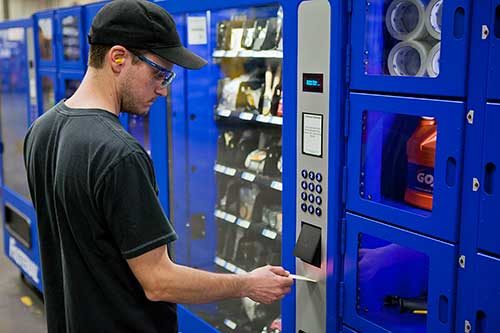PPE at the point of use
What are the benefits of having personal protective equipment at the point of use?

Responding is Joseph Solheid, director of safety sales, Fastenal, Winona, MN.
Too often, safety managers act as inventory managers. They’re busy handing employees PPE when their focus should be on worker and workplace safety. It’s easy to see an opportunity for improvement in terms of efficiency and productivity when employees spend a notable amount of time walking and waiting to get the required PPE for daily tasks.
Do your employees always know what PPE they should be wearing? You can create a culture of knowledge when it comes to PPE with simplified signage and easy product selection guides right where the work happens.
What options exist to move PPE closer to workers?
Crib-based: If the workspace is small, having a crib stocked with PPE is one way to go, assuming workers are close enough that walking to the crib won’t take a lot of time. Many companies outgrow this type of PPE distribution.
Free issue: With a larger floor plan, it becomes more obvious that PPE needs to be right at the point of use. Workers who have to go to a crib for PPE either lose productive time walking or can begin to stockpile gear near their work area, causing inventory bloat. Stocking free-issue bins or stations near workers allows them to have what they need, when it’s needed. This option cuts down on walking time but can lead to workers not using PPE to its full end-of-service life.
Vending: Workers can still build a stash of their favorite gloves or glasses in a free-issue system. Vending can control that through built-in tracking and reporting capabilities. Workers swipe their badge to get a pair of gloves and the system tracks it. Accountability measures can be set so workers can’t vend more than they need. Having automated reports on PPE use can provide information that you might not think about, such as a worker who never checks out PPE. This offers a chance to act on a teaching moment before there’s a problem. Also, predictive analytics can help safety mangers drive injury rates closer to zero.
Common benefits of PPE at the point of use:
- Reduced walk and wait time.
- Increased compliance and productivity.
- Workers know the proper PPE to wear for the job.
- Wherever you are in the facility, compliant product is nearby and visible.
With industrial vending, you have all of the benefits listed above, as well as:
- A clear view of who, what, when and how many in regard to the dispensing of PPE.
- 24/7 automated replenishment and accountability.
- Staying compliant – ensuring the right people have the right product for the right hazards.
Think about the time spent walking, workers stockpiling PPE, use reports and 24/7 access. Take all of these factors into consideration when you plan out how to move PPE closer to the point of work.
Editor's note: This article represents the independent views of the author and should not be construed as a National Safety Council endorsement.
Post a comment to this article
Safety+Health welcomes comments that promote respectful dialogue. Please stay on topic. Comments that contain personal attacks, profanity or abusive language – or those aggressively promoting products or services – will be removed. We reserve the right to determine which comments violate our comment policy. (Anonymous comments are welcome; merely skip the “name” field in the comment box. An email address is required but will not be included with your comment.)

